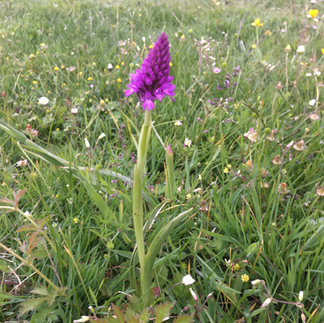Should You Do No Mow May?
- Jules Miller
- Apr 28
- 4 min read
No Mow May is a simple idea: you stop mowing your lawn for the month of May to let grasses and wildflowers grow. This provides vital nectar and shelter for pollinators like bees and butterflies just as they emerge from hibernation. In turn, these insects support birds, bats, and other wildlife - and you save time and effort too!
Lawns are part of a living ecosystem, full of fungi, worms, microbes, and insects. With insect populations declining by up to 40%, mainly due to habitat loss and pesticide use, letting parts of your lawn grow can make a real difference.
Before You Start.

Think about how you use your lawn. If you have children who play ballgames on it, for example, then letting your whole lawn grow long is not necessarily going to be the best option for you. It might be better to leave just part of the lawn to grow long rather than the whole lawn.
Also consider that wildlife is more likely to use a strip of longer grass that’s near to shelter, for example along a hedge or fence line, rather than an exposed area in the centre of the grass.
If you decide to create a mini meadow area you will need to learn about the best way to turn your lawn into meadow as it does require more than just letting the grass grow (https://www.rhs.org.uk/lawns/creating-wildflower-meadows). Letting some areas grow long in No Mow May could be an easy way of starting to experiment with it though.
Are Lawns Bad?
No! Lawns can be made up of thousands of plants and offer environmental benefits like absorbing heat, rainwater and carbon, but frequent mowing and heavy chemical use reduce these benefits. Lawns don’t have to be “perfect” to be valuable for wildlife.

How to Approach No Mow May.
Give your lawn a cut in April to prepare as many wildflowers emerge best from shorter grass.
Diversity is key - let some areas grow long and keep others short to boost biodiversity.
Early in May, not much will happen, but after a couple of weeks wildflowers like daisies, clover, buttercups, and orchids if you’re lucky, will start to bloom.
You probably won’t get a lawn full of beautiful wildflowers in the first year of ‘No Mow May’. If you do want a meadow lawn with wildflowers, you will have to actively create one, not just stop mowing. (https://www.wottonareacan.org/post/planting-wild-flower-seeds)
Leaving your grass uncut beyond May into summer or even autumn before cutting can be really helpful for supporting biodiversity and allowing more wild flowers to appear.

Are There Potential Downsides? Not everyone loves the look of an overgrown lawn, and some neighbours might not understand why you’re leaving it unmown. Be prepared to explain that you are trying to support biodiversity. If you want to return to a well-manicured lawn after May, there is also a risk of patchy grass after a sudden, short cut.
Lawn grasses bred for frequent cutting may become thin if left unmown, so overseeding in later in the year may be needed.
It has been suggested that it is counterproductive to create a beautiful wildlife habitat and then chop it down and that truly valuable wildlife habitat develops over time and should be permanent rather than transitory. What happens to the wildlife that has enjoyed your longer lawn? By June, the natural world is fully embracing summer. There's an abundance of greenery, flowers, and habitats compared to earlier in the year. When you do mow your lawn, wildlife is more likely to find alternative shelter and food nearby.
You can also actively support biodiversity by planting wildlife-friendly species along your borders.
When mowing, it's best to start from the centre of the lawn and work outward toward the edges. This technique gives small creatures like frogs and toads a better chance to escape safely.
Will No Mow May Damage My Lawn?
The real risk comes if you let your grass grow long and then cut it very short all at once. Removing most of the leaf area exposes brown stems underneath, leaving your lawn vulnerable. If June turns out to be dry, the grass will struggle to recover, and weeds can quickly take over any bare patches.
To protect your lawn, set your mower to the highest setting for the first cut after a long growth period. Then, wait at least a week before making a second, slightly lower cut. This approach allows the grass to adapt by regrowing shorter leaves, making it healthier and more resilient.

An Alternative to No Mow May?
If you want a lawn that's more welcoming to
wildlife but don't love the idea of letting the grass grow wild for a month, you can simply mow less often. A tightly trimmed lawn, kept around 2 inches high, usually needs weekly mowing, especially in warm, wet weather.But by allowing the grass to grow a little longer, up to about 4 inches, you'll reduce how often you need to mow. It also gives small plants like clover and daisies the chance to bloom low to the ground. Occasionally leaving your grass clippings on the lawn will help too, as they naturally break down and feed the soil.
It’s less work for you and better for nature.










